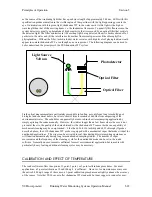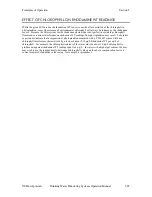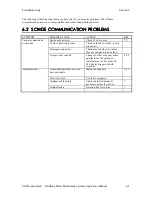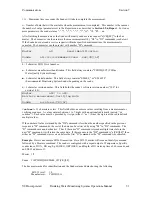
Principles of Operation
Section 5
YSI Incorporated Drinking Water Monitoring Systems Operation Manual
5-20
From our studies, it appears that entry of a value of 1 to 2 % per degree C for “Chl tempco” is appropriate
to partially account for changes in the fluorescence of environmental phytoplankton with temperature. This
value can be estimated in the above example as follows:
Change in Temperature = 21–1 = 20 °C
Change in Fluorescence = 226-185 = 41 µg/L
% Change in Fluorescence = (41/185) x 100 = 22.1
Chl Tempco Factor = 22.1/20 = 1.11 % per degree °C
Note that the use of this empirically derived compensation does not guarantee accurate field readings since
each species of phytoplankton is likely to be unique with regard to the temperature dependence of its
fluorescence. Changes in fluorescence with temperature are a key limitation of the
in vivo
fluorometric
method (see below) which can only be reduced, not eliminated, by this compensation. In general, the best
way to minimize errors is to calibrate with phytoplankton standards of known chlorophyll content that are
as close as possible in temperature to that of the environmental water under investigation.
EFFECT OF FOULING ON OPTICAL MEASUREMENTS
Field optical measurements are particularly susceptible to fouling, not only from long term build up of
biological and chemical debris, but also to shorter term formation of bubbles from outgassing of the
environmental water. These bubbles can sometimes be removed in short term sampling applications by
simply agitating the sonde manually. For studies longer than a few hours where the user is not present at
the site, the quality of the chlorophyll data obtained with a fluorescence sensor that has no capability of
mechanical cleaning is likely to be compromised. The YSI 6025 probe is equipped with a mechanical
wiper that makes it ideal for unattended applications. The wiper can be activated in real-time during
discrete sampling operations or will function automatically just before each sample is taken during long
term unattended monitoring studies. The number of wiper movements and the frequency of the cleaning
cycle for the unattended mode can be set in the sonde software. Generally, one wiper movement is
sufficient for most environmental applications, but in media with particularly heavy fouling, additional
cleaning cycles may be necessary.
EFFECT OF TURBIDITY ON CHLOROPHYLL READINGS
As described above, the filters in front of the photodiode in the YSI 6025 chlorophyll probe prevent most of
the 470 nm light which is used to excite the chlorophyll molecules from reaching the detector after being
backscattered off of non-fluorescent particles (turbidity) in environmental water. However, the filter system
is not perfect and a minor interference on chlorophyll readings from suspended solids may result.
Laboratory experiments indicate that a suspension of typical soil measured with a YSI 6026 sensor will
have a turbidity interference characterized by a factor of about 0.03 µg/L per NTU. For example, the
turbidity of the water must be above 100 NTU to produce an apparent chlorophyll reading equal to 3 µg/L.
In very cloudy water, the user may wish to use the independently-determined turbidity value and the above
compensation factor to correct measured chlorophyll values using, for example, a spreadsheet.
LIMITATIONS OF
IN VIVO CHLOROPHYLL
MEASUREMENTS
As noted above, the measurement of chlorophyll from
in vivo
fluorescence measurements will always be
less reliable than determinations made on molecular chlorophyll that has been extracted from the cells
using the procedures described in
Standard Methods
. This section describes some of the known problems
with
in vivo
chlorophyll measurement.















































